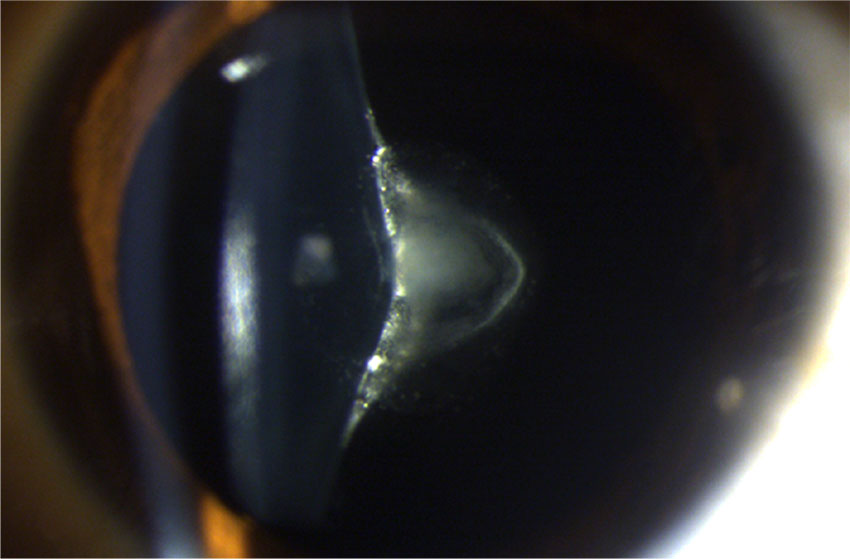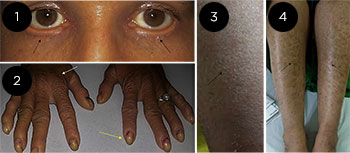Download PDF
Make your diagnosis in the comments, and look for the answer in next month’s Blink.

Last Month’s Blink
Bilateral Ectropion in Nonbullous Ichthyosiform Erythroderma
Written by Nitin Kumar, MBBS, MS, and Zoramthara Zadeng, MBBS, MS, Advanced Eye Centre, Postgraduate Institute of Medical Education and Research, Chandigarh, India. Photos by the authors.

A 34-year-old woman presented with a six-month history of tearing, foreign body sensation, and outward turning of lid margins in both eyes. Her visual acuity was 20/20 in the right and left eyes. Examination revealed bilateral lower lid ectropion and loss of cilia, along with whitish scales on the skin around the eyelids and face (Fig. 1). Scales and dry skin were present all over her body, especially on the extensor aspects of the hands (Fig. 2), forearms (Fig. 3), and legs, which also had thick, dry, platelike scales (Fig. 4). In addition, she had clubbing of the fingernails (Fig. 2). She also complained of decreased sweating. Notably, the patient had been born with a collodion membrane, which exfoliates over time, leaving scales on the body. She was referred to the dermatology clinic, where a diagnosis of nonbullous congenital ichthyosiform erythroderma (NBCIE) was made, and the patient was started on daily oral acitretin and local application of emollients.
NBCIE is a rare, autosomal recessive, chronic inflammatory ichthyosis without blister formation. It is estimated to occur in 1:300,000 newborns of all races. Most common mutations leading to NBCIE are seen in ALOX12B, ABCA12, TGM1, and ALOXE genes.
Many affected individuals are born with a collodion membrane, an epidermal keratinization disorder caused by defective protein and lipid metabolism. The membrane exfoliates over time, leaving scales all over the body. Ophthalmic findings include scales on the eyelids, loss of eyelashes, ectropion, dry eyes, epiphora, and corneal scarring with exposure keratopathy, corneal erosions, and perforations. Disease symptoms are severe in children; ectropion of both upper and lower eyelids is common, and conjunctival hyperemia, stem cell deficiency, and corneal erosions can occur with fissuring of eyelid skin.
There is no cure for NBCIE; supportive treatment includes topical application of keratolytic agents, emollients, frequent lubricant drops, and topical or systemic retinoids. Severe cases may require tarsorrhaphy, skin grafting, and systemic immunosuppression.
Read your colleagues’ discussion.
| BLINK SUBMISSIONS: Send us your ophthalmic image and its explanation in 150-250 words. E-mail to eyenet@aao.org, fax to 415-561-8575, or mail to EyeNet Magazine, 655 Beach Street, San Francisco, CA 94109. Please note that EyeNet reserves the right to edit Blink submissions. |